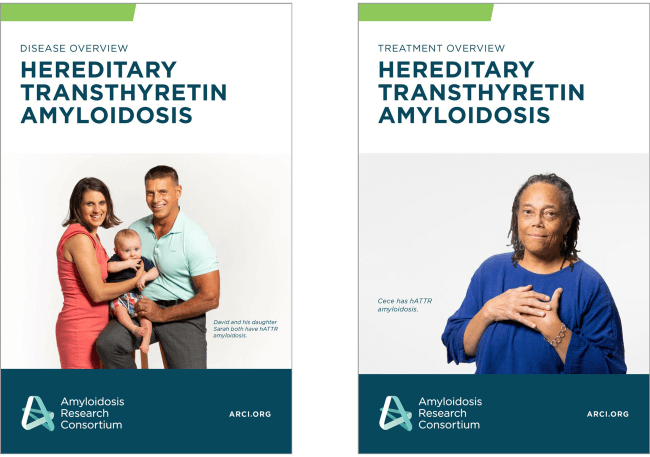
Hereditary ATTR Amyloidosis
Hereditary ATTR (hATTR) amyloidosis is passed down through families.
Hereditary ATTR amyloidosis is caused by a fault or mutation in the transthyretin (TTR) gene which is inherited (i.e. runs in families). The mutation results in an abnormal TTR protein that is unstable and readily misfolds, forming aggregates which deposit as amyloid in various organs and tissues in the body. TTR is mostly made in the liver. Its role is to transport the hormone thyroxine and retinol (Vitamin A) around the body, hence its name transthyretin.
3D animated overview of ATTR amyloidosis
Types of ATTR amyloidosis
Two main types of ATTR amyloidosis exist:
- Hereditary ATTR amyloidosis (hATTR)
Caused by a faulty or mutated gene that is inherited, i.e. runs in the family - Wild-type ATTR amyloidosis (ATTRwt)
Develops with age; acquired not inherited
Learn more about wild-type ATTR
There are over 120 different mutations in the TTR gene but, as research continues, it is possible that more may be identified. Each different mutation causes a different pattern of disease onset, symptoms and outlook. The most common ATTR mutations are the:
- ATTR V30M variant – found mostly in Portugal, Spain, France, Sweden, Japan and descendants of these regions
- ATTR V122I variant – seen in 3-4% of African Americans
- ATTR T60A variant – seen in people of Irish descent and the most common variant in the UK
Hereditary ATTR (hATTR) Educational Booklets
Dawn describes her experience as a hereditary amyloidosis caregiver and patient, experiencing the onset of symptoms, her treatment journey, and advice for others living with hATTR amyloidosis.
Sean Riley describes his symptoms, seven-year journey to diagnosis, undergoing bilateral carpal tunnel surgery, and advice for others living with hereditary ATTR amyloidosis.
A patient’s experience living with hereditary amyloidosis
Symptoms of hereditary ATTR amyloidosis vary depending on the genetic variant, the organs that have been affected, and the extent to which the amyloid deposits have caused damage. Symptoms can start at any time in adulthood. Common symptoms include:
- Cardiomyopathy – Shortness of breath, palpitations and abnormal heart rhythm, ankle swelling (edema), fainting, fatigue, chest pain (angina)
- Peripheral neuropathy – Tingling and numbness in legs and feet, difficulty walking, limb weakness and pain
- Autonomic neuropathy – Light-headedness when standing (orthostatic hypotension), bladder problems, bowel problems, sexual dysfunction
- Gastrointestinal – Decreased appetite, diarrhea, nausea, stomach pain, weight loss
Some ATTR variants are associated with specific symptoms. For example, the ATTR V30M variant typically causes symptoms associated with peripheral neuropathy, whereas the ATTR V122I variant typically causes symptoms associated with cardiomyopathy. Most patients, however, will have symptoms which indicate multiple organ involvement, regardless of what variant they have.
If ATTR amyloidosis is suspected, a number of tests are carried out including an abdominal fat pad biopsy to confirm the presence of amyloid deposits.
Tests are also done to determine the effect of the amyloid deposits on the heart, nerves and other organs. These tests include blood, nerve and muscle tests, echocardiogram, MRI and other types of scans. In some cases, organ biopsies may also be completed to determine organ involvement. Some scans can help identify the type of amyloidosis and distinguish ATTR from AL amyloidosis in the heart. Doctors also use other tests, called immunohistochemistry and mass spectrometry, to differentiate between ATTR and AL amyloidosis.
Hereditary ATTR amyloidosis is confirmed if a blood test shows a genetic mutation in the TTR gene. The test will be able to determine which variant it is. In such cases, it may be recommended for other members of the family to consider getting genetic testing.
Up until recently, a liver transplant has been the only option for treatment of hereditary ATTR amyloidosis. TTR is mostly made by the liver and a transplant will reduce the production of the abnormal TTR protein.
More recently, several drugs exist for the treatment of hATTR, some of which are still investigational and some of which are FDA approved. These treatments each have different therapeutic approaches and are aimed at:
- Stabilizing the TTR protein
- Stopping the production of TTR protein
- Removing the amyloid deposits
Stabilizing the TTR protein: The approach of TTR stabilizers is to stop the TTR protein from forming amyloid deposits.
Drug status report:
- Diflunisal – Approved in the U.S. by the FDA as a non-steroidal, anti-inflammatory drug (NSAID) that has shown to bind to the TTR protein in the blood and may thereby prevent the formation of amyloid.
- Vyndaqel / Vyndamax (tafamidis) – Has been approved by the FDA in the U.S. for the treatment of transthyretin amyloidosis cardiomyopathy (ATTR-CM). Vyndaqel has also been approved in 41 countries outside of the U.S. to treat transthyretin amyloidosis polyneuropathy (ATTR-PN) – view factsheet
- Attruby (acoramidis) – Approved by the FDA for use in the U.S., Attruby is a TTR stabilizer developed for treating patients with transthyretin amyloidosis (ATTR) who have heart involvement (cardiomyopathy) – view factsheet
Stopping production of TTR: The approach in stopping production of TTR proteins is through ‘gene silencing’. Novel treatments known as “gene silencers” have shown promising results in clinical studies. They prevent TTR protein production by blocking the TTR gene. These treatments have been approved and are currently available for use for hATTR peripheral neuropathy, and Vutrisiran (Amvuttra) has been approved for use for hATTR cardiomyopathy.
Drug factsheets:
- Patisiran (Onpattro) — view factsheet
- Vutrisiran (Amvuttra) — view polyneuropathy factsheet | view cardiomyopathy factsheet
- Eplontersen (Wainua) — view factsheet
Removing amyloid deposits
There are currently no approved drugs aimed at removing amyloid deposits in hATTR.
Drug status report:
- PRX004 – Currently being tested in clinical trials.
Supportive treatment
Although they do not address the underlying cause, supportive treatments are important to help alleviate symptoms and improve quality of life. Overall, factors such as age, general health and extent of organ damage are taken into account when deciding on treatment.
Amyloidosis is a multi-system disease, meaning it affects multiple organs. It is important to be seen at a center that has experience in diagnosing and treating your type of amyloidosis. These centers will have a group of different specialists (i.e., cardiologist, hematologist, neurologist) who will be able to provide a comprehensive evaluation and treatment plan. Learn more about ARC’s treatment center finder MAP here.
Learning about clinical trials can be an important part of your care. In a rare disease such as amyloidosis, treatment options are often limited, and clinical trials may be the best way for you to access new therapies. To learn more about the basics of clinical trials, click here.




